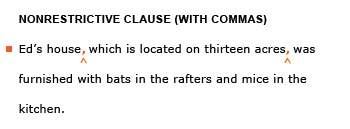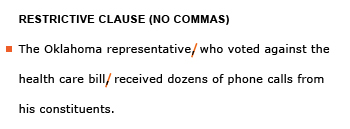Commas with adjective clauses
Adjective clauses begin with a relative pronoun (who, whom, whose, which, that) or with a relative adverb (where, when). They contain a subject and a verb but they cannot stand alone—they modify a noun or pronoun in the sentence. They always follow the word they modify, usually immediately.
Adjective clauses are either restrictive or nonrestrictive. Nonrestrictive adjective clauses are set off with commas; restrictive adjective clauses are not.

The clause which is located on thirteen acres does not add essential information about the identity of the house, so the clause should be set off with commas.

There is only one Shakespeare, so the modifier cannot restrict the meaning. Use commas here to set off non-essential information.

Ramona has more than one cat. Because the adjective clause that just had kittens identifies the particular cat, the information is essential (no commas).

There are several representatives from Oklahoma; the adjective clause who voted against the health care bill identifies the specific representative. It is therefore essential to the meaning of the sentence and is not set off with commas.
NOTE:Use that only with restrictive clauses. Many writers prefer to use which only with nonrestrictive clauses, but usage varies.
Exercises:
Major uses of the comma 1
Major uses of the comma 2
All uses of the comma
Related topics:
Commas and restrictive and nonrestrictive elements: Overview
Distinguishing between restrictive and nonrestrictive from context
Commas with adjective phrases
Commas with appositives